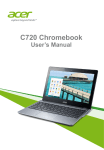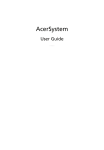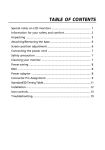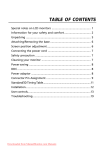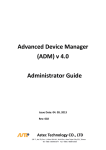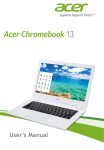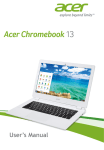Download Acer Aspire 1110X Owner's Manual
Transcript
User Guide Copyright © 2012. All Rights Reserved. Acer Predator G Series User Guide Original Issue: 03/2012 Acer Predator G Series Desktop Computer Model number: __________________________________ Serial number: ___________________________________ Purchase date: ___________________________________ Place of purchase: ________________________________ Visit http://registration.acer.com and discover the benefits of being an Acer customer. Remark: All images are for reference purposes only. Actual configuration may vary. iii Information for your safety and comfort Safety instructions Read these instructions carefully. Keep this document for future reference. Follow all warnings and instructions marked on the product. Turning the product off before cleaning Unplug this product from the wall outlet before cleaning. Do not use liquid cleaners or aerosol cleaners. Use a damp cloth for cleaning. Warnings • • • • • Do not use this product near water. Do not place this product on an unstable cart, stand or table. If the product falls, it could be seriously damaged. Slots and openings are provided for ventilation to ensure reliable operation of the product and to protect it from overheating. These openings must not be blocked or covered. The openings should never be blocked by placing the product on a bed, sofa, rug or other similar surface. This product should never be placed near or over a radiator or heat register, or in a built-in installation unless proper ventilation is provided. Never push objects of any kind into this product through cabinet slots as they may touch dangerous voltage points or short-out parts that could result in a fire or electric shock. Never spill liquid of any kind onto or into the product. To avoid damage of internal components and to prevent battery leakage, do not place the product on a vibrating surface. Using electrical power • • • • This product should be operated from the type of power indicated on the marking label. If you are not sure of the type of power available, consult your dealer or local power company. Do not allow anything to rest on the power cord. Do not locate this product where people will walk on the cord. If an extension cord is used with this product, make sure that the total ampere rating of the equipment plugged into the extension cord does not exceed the extension cord ampere rating. Also, make sure that the total rating of all products plugged into the wall outlet does not exceed the fuse rating. Do not overload a power outlet, strip or receptacle by plugging in too many devices. The overall system load must not exceed 80% of the branch circuit rating. If power strips are used, the load should not exceed 80% of the power strip's input rating. iv • This product's AC adapter is equipped with a three-wire grounded plug. The plug only fits in a grounded power outlet. Make sure the power outlet is properly grounded before inserting the AC adapter plug. Do not insert the plug into a non-grounded power outlet. Contact your electrician for details. Warning! The grounding pin is a safety feature. Using a power outlet that is not properly grounded may result in electric shock and/or injury. Note: The grounding pin also provides good protection from unexpected noise produced by other nearby electrical devices that may interfere with the performance of this product. • Use the product only with the supplied power supply cord set. If you need to replace the power cord set, make sure that the new power cord meets the following requirements: detachable type, UL listed/CSA certified, type SPT-2, rated 7 A 125 V minimum, VDE approved or its equivalent, 4.6 meters (15 feet) maximum length. Product servicing Do not attempt to service this product yourself, as opening or removing covers may expose you to dangerous voltage points or other risks. Refer all servicing to qualified service personnel. Unplug this product from the wall outlet and refer servicing to qualified service personnel when: • The power cord or plug is damaged, cut or frayed • • • • • Liquid was spilled into the product The product was exposed to rain or water The product has been dropped or the case has been damaged The product exhibits a distinct change in performance, indicating a need for service The product does not operate normally after following the operating instructions Note: Adjust only those controls that are covered by the operating instructions, since improper adjustment of other controls may result in damage and will often require extensive work by a qualified technician to restore the product to normal condition. v CAUTION: Danger of explosion if battery is incorrectly replaced. Replace only with the same or equivalent type recommended by the manufacturer. Dispose of used batteries according to the manufacturer’s instructions. Telephone line safety • • Disconnect all telephone lines from the equipment when not in use and/or before servicing. To avoid the remote risk of electric shock from lightning, do not connect the telephone line to this equipment during lightning or thunderstorms. Disposal instructions Do not throw this electronic device into the trash when discarding. To minimize pollution and ensure utmost protection of the global environment, please recycle. For more information on the Waste from Electrical and Electronics Equipment (WEEE) regulations, visit www.acer-group.com/public/Sustainability/sustainability01.htm www.acer-group.com/public/Sustainability/sustainability04.htm. Mercury advisory For projectors or electronic products containing an LCD/CRT monitor or display: Lamp(s) inside this product contain mercury and must be recycled or disposed of according to local, state or federal laws. For more information, contact the Electronic Industries Alliance at www.eiae.org. For lamp-specific disposal information, check www.lamprecycle.org. Tips and information for comfortable use Computer users may complain of eyestrain and headaches after prolonged use. Users are also at risk of physical injury after long hours of working in front of a computer. Long work periods, bad posture, poor work habits, stress, inadequate working conditions, personal health and other factors greatly increase the risk of physical injury. vi Incorrect computer usage may lead to carpal tunnel syndrome, tendonitis, tenosynovitis or other musculoskeletal disorders. The following symptoms may appear in the hands, wrists, arms, shoulders, neck or back: • • • • • numbness, or a burning or tingling sensation aching, soreness or tenderness pain, swelling or throbbing stiffness or tightness coldness or weakness If you have these symptoms, or any other recurring or persistent discomfort and/or pain related to computer use, consult a physician immediately and inform your company's health and safety department. The following section provides tips for more comfortable computer use. Finding your comfort zone Find your comfort zone by adjusting the viewing angle of the monitor, using a footrest, or raising your sitting height to achieve maximum comfort. Observe the following tips: • • • • • • • refrain from staying too long in one fixed posture avoid slouching forward and/or leaning backward stand up and walk around regularly to remove the strain on your leg muscles take short rests to relax your neck and shoulders avoid tensing your muscles or shrugging your shoulders install the external display, keyboard and mouse properly and within comfortable reach if you view your monitor more than your documents, place the display at the center of your desk to minimize neck strain Taking care of your vision Long viewing hours, wearing incorrect glasses or contact lenses, glare, excessive room lighting, poorly focused screens, very small typefaces and low-contrast displays could stress your eyes. The following sections provide suggestions on how to reduce eyestrain. Eyes • • • Rest your eyes frequently. Give your eyes regular breaks by looking away from the monitor and focusing on a distant point. Blink frequently to keep your eyes from drying out. Display • Keep your display clean. • Keep your head at a higher level than the top edge of the display so your eyes point downward when looking at the middle of the display. vii • • • • Adjust the display brightness and/or contrast to a comfortable level for enhanced text readability and graphics clarity. Eliminate glare and reflections by: • placing your display in such a way that the side faces the window or any light source • minimizing room light by using drapes, shades or blinds • using a task light • changing the display's viewing angle • using a glare-reduction filter • using a display visor, such as a piece of cardboard extended from the display's top front edge Avoid adjusting your display to an awkward viewing angle. Avoid looking at bright light sources, such as open windows, for extended periods of time. Developing good work habits Develop the following work habits to make your computer use more relaxing and productive: • Take short breaks regularly and often. • • • Perform some stretching exercises. Breathe fresh air as often as possible. Exercise regularly and maintain a healthy body. Warning! We do not recommend using the computer on a couch or bed. If this is unavoidable, work for only short periods, take breaks regularly, and do some stretching exercises. Note: For more information, please refer to FCC notice on page 34. viii Safety instructions Disposal instructions Tips and information for comfortable use iii iii v v 1 First things first 1 Package contents Accessing the User Guide 2 2 2 System tour 3 External structure 4 Front panel Information on USB 3.0 Using the memory card reader Rear panel Environment 3 Setting up your computer Arranging a comfortable work area Adjusting your chair Positioning your PC Positioning your monitor Positioning your keyboard Positioning your mouse Connecting the computer Connect your mouse and keyboard PS/2 interface USB interface Connect a monitor (optional) Connect to a broadband network Individual network configuration Connect to power 4 5 6 7 7 9 10 10 10 11 11 11 12 12 12 12 12 12 12 13 Turning on your computer Turning off your computer Acer clear.fi (only for certain models) 13 13 14 Navigating media and photos Shared files 14 14 Contents Information for your safety and comfort x Which devices are compatible? Playing to another device 15 15 4 Using your computer 17 Using the optical drive 18 Taking care of your optical discs Connecting options Audio devices USB devices 19 19 19 19 5 Upgrading your computer 21 Installation precautions 22 ESD precautions Preinstallation instructions Post-installation instructions Opening your computer Removing and installing a hard drive Upgrading the system memory System memory interface System memory configuration guidelines 22 22 23 23 24 27 27 27 6 Frequently asked questions 29 Frequently asked questions 30 7 Regulations and safety notices 33 Regulations and safety notices 34 FCC notice Modem notices Laser compliance statement Digital audio output statement Radio device regulatory notice Canada — Low-power license-exempt radio communication devices (RSS-210) Federal Communications Commission 34 36 38 38 38 38 41 1 First things first English 2 1 First things first Package contents Before you unpack your computer, make sure that you have enough space to set up your computer. Carefully unpack the carton and remove the contents. If any of the following items are missing or damaged, contact your dealer immediately: • Acer Predator G Series • Items contained in the accessory box • USB keyboard • USB mouse • Setup poster • Other user documentation and third-party software Accessing the User Guide This User Guide is also available on your computer as an Adobe Acrobat PDF file. To access the User Guide 1 On the Windows taskbar, click on the Start button then select All Programs. 2 Double-click AcerSystem User Guide. 2 System tour English 4 External structure Front panel 2 System tour 5 Icon Component 1 USB 2.0/3.0 ports 2 Optical disc drives 3 Media card slots 4 Easy-swap hard disk cartridge 5 Drive bay door 6 Optical disk drive eject buttons 7 Microphone/line-in jack 8 Headphone/line-out jack Information on USB 3.0 • • • Compatible with USB 3.0 and earlier devices. For optimal performance, use USB 3.0-certified devices. Defined by the USB 3.0 specification (SuperSpeed USB). English No English 6 2 System tour Using the memory card reader Your computer supports multi-media card slots. These slots are useful for transferring data to and from memory cards to your computer. Memory cards are used in a variety of digital devices such as digital camera, digital camcorders, handheld game consoles, and mobile phones. To insert a memory card: 1 Hold the card label-side up with the card facing the computer. 2 Slide the card into the slot until it is seated. To remove a memory card: 1 Before ejecting a card: Exit the application using the card. Left-click on the Safely Remove Hardware icon on the Windows taskbar and stop the card operation. • • 2 Gently press the card further into the slot to pop it out. 3 Pull out the card from the slot. 7 Icon Component Power supply PS/2 mouse port System fan Network port Headphone/line-out/front speaker jack Audio-in/line-in jack Microphone/line-in jack USB ports PS/2 keyboard port Power connector Environment • Temperature: • Operating: 5°C to 35°C • Non-operating: -20°C to 65°C • Humidity (non-condensing): • Operating: 20% to 80% • Non-operating: 20% to 80% English Rear panel English 8 2 System tour 3 Setting up your computer English 10 3 Setting up your computer Arranging a comfortable work area Working safely and comfortably begins with the arrangement of your work space and the proper use of equipment. For this reason, it is very important to take time and think about how you are going to arrange your work area. Refer to the diagram on the following page as you set up your system. Here are some points to consider: Adjusting your chair Having the right kind of chair does not necessarily mean you'll be properly supported. It is necessary to adjust your chair to fit your body. Proper body posture will make you more comfortable and productive. • Avoid tilting your chair. If you have a chair that tilts, lock the tilt knobs so that your chair will not tilt forward or backward while you are using your computer. • Adjust your chair height in such a way that you can sit on it with your thighs parallel to the floor and your feet resting flat on the floor. • Rest your body on the chair back. Your torso works harder to maintain balance if you do not rest your body on the chair back. Positioning your PC 11 • Do not put your computer near any equipment that might cause electromagnetic or radio frequency interference, such as radio transmitters, televisions, copy machines or heating and air-conditioning equipment. • Avoid dusty areas and extremes of temperature and humidity. • You may place your computer beside your desk or under your table, as long as it does not block the space you need for working and moving. Positioning your monitor Place your monitor at a comfortable viewing distance, usually 50 to 60 cm away. Adjust the display in such a way that the top of the screen is at or slightly below eye level. Positioning your keyboard The location of the keyboard is a very important factor for your posture. Placing it too far away will make your body lean forward, forcing you to sit in an unnatural position. Placing it too high will add tension to your shoulder muscles. • The keyboard should be placed just above your lap. Adjust the keyboard height by flipping the folding stands located under the keyboard. • Keep your lower arms parallel to the floor as you type. Your upper arms and shoulders should be relaxed. Then try typing with a light touch. If you feel any shoulder or neck strain, stop for a while and check your posture. • Position your keyboard in front of your monitor. Putting your keyboard beside your monitor will make you turn your head while you type which could add tension to your neck muscles. Positioning your mouse • The mouse should be placed on the same surface as your keyboard so that you can reach it with ease. • Adjust its position to allow enough space for movement without making you stretch or lean over. • Use your arm to move the mouse. Do not rest your wrist on the table when moving the mouse. English Take note of the following when selecting a location for your computer: English 12 3 Setting up your computer Connecting the computer Setting up your computer is easy. For the most part, you only have four things to connect: the mouse, the keyboard, the monitor, and the power cable. Note: The peripherals shown in the connections below are for your reference only. Actual device models may vary in select countries. Connect your mouse and keyboard PS/2 interface Plug the PS/2 mouse and keyboard cable into the PS/2 keyboard port (purple port) and mouse port (green port) located on the rear panel of your computer. USB interface You can also plug a USB mouse or a USB keyboard cable into any of the USB ports located on the front and rear panels of your computer. Connect a monitor (optional) To connect a monitor, simply plug the monitor cable into the DVI port located on the rear panel of your computer. If you have a monitor that supports S-video, plug the monitor cable to the S-video port located on the rear panel of your computer. Note: Refer to the monitor manual for additional instructions and information. Connect to a broadband network Individual network configuration Connect one end of the network cable on the network port on the rear of the computer, then connect the other end of the network cable into the cable modem or network jack or hub on your network. Note: Consult your network system administrator or operating system manual for information on how to configure your network setup. 13 Caution: Before you proceed, check the voltage range in your area. Make sure that it matches your computer's voltage setting. If they don't match, change your computer's voltage setting according to your area's voltage range. 1 Plug the power cable into the power cable socket located on the rear panel of your computer. 2 Plug the other end of the power cable into a power outlet. Turning on your computer After making sure that you have properly set up the system, applied power, and connected all the necessary peripherals, you can now power on the system. Follow the procedure below. 1 Turn on the main power switch located on the rear of the computer. 2 Press the power button. Important: Make sure that the power cable is properly plugged into an electrical outlet. If you are using a power strip or an AVR (Auto-Voltage Regulator), make sure that it is plugged in and turned on. Turning off your computer The software procedure below applies to system running a Windows OS. For other OS shutdown procedures, refer to the related user documentation. 1 On the Windows taskbar, click on the Start button, then click Shut Down. 2 Turn off all peripherals connected to your computer. If you cannot shut down your computer normally, press and hold the power button for at least four seconds. Quickly pressing the button may put the computer in suspend mode only. English Connect to power English 14 Acer clear.fi (only for certain models) With Acer clear.fi, you can enjoy videos, photos and music. Stream media from, or to, other devices with Acer clear.fi installed. Note: All devices must be connected to the same network. To watch videos or listen to music open clear.fi Media, to browse photos open clear.fi Photo. Important: When you first open a clear.fi application, Windows Firewall will ask for permission to allow clear.fi to access the network. Select Allow Access in each window. Navigating media and photos The list in the left panel shows your computer (’My Library’), then other devices if any are connected to your network (’Home Shared’). To view files on your computer, select one of the categories under ’My Library’, then browse the files and folder on the right. Shared files Devices connected to your network are shown in the Home Shared section. Select a device, then the select the category to explore. After a short delay, shared files and folders are shown on the right. Browse to the file you want to play, then double-click to start playback. Use the media controls in the bar across the bottom of the screen to control playback. For example, when music is selected, you can play, pause or stop playback, and adjust the volume. 15 Which devices are compatible? Certified Acer devices with clear.fi or DLNA software can be used with the clear.fi software. These include DLNA-compliant PCs, smartphones, and NAS (Network Attached Storage) devices. Playing to another device If you want to play the media on another device, you need to do the following: 1 In the bottom right corner, select Play to. 2 Select the remote device that will be used to play the file. Only devices optimised for playback are available in this list, certain PCs and storage devices will not appear. To add a Windows PC to this list, open Windows Media Player, select Stream and Allow remote control of my Player... 3 Select a file in the main window, then use the media controls in the bar across the bottom of the screen to control the remote device. For more help, go to http://www.acer.com/. English Note: You must activate sharing on the device that stores the files. Open clear.fi on the device that stores the files, select Edit then make sure Share my library on local network is active. English 16 4 Using your computer English 18 4 Using your computer Using the optical drive Your computer may come with a Blu-ray reader + SuperMulti burner. This drive is located on the front panel of your computer. The BD and HD drive allows you to play CD-ROMs, CD-I discs, and video CDs, DVD-RAM/-RW, DVD-ROMs, DVD+R/R discs, but play BD discs as well. CDs, DVDs, BDs are also compact, lightweight and easy to carry around. However, they are more delicate and must be handled with extra care. To insert a disc into your computer's optical drive: 1. Press the optical drive’s eject button located on the front panel. 2. When the disc tray slides open, place the disc gently on the tray. Make sure that the label or title side of the disc is facing upward. When holding a disc, hold it by the edges to avoid leaving smudges or fingerprints. 3. Push the tray and it will close automatically or press the eject/load button. 19 • Keep your disc in its case when not in use to avoid scratches or other damage. Any kind of dirt or damage can affect the data on the disc, impair the disc lens reader on the optical drive, or stop the computer from successfully reading the disc. • When handling discs, always hold them by the edges to avoid smudges or fingerprints. • When cleaning discs, use a clean, dust-free cloth and wipe in a straight line from the center to the edge. Do not wipe in a circular motion. • Clean you optical drive periodically with a cleaning kit; cleaning kits may be purchased at any computer or electronics shop. Connecting options Your computer offers excellent expansion capabilities with its built-in ports and connectors. This section describes how to make connections through various options. When connecting peripherals, read the manual included with the peripheral for operating instructions. Audio devices Audio devices are easy to connect with the audio ports accessible from the front and rear of the computer. • Microphone — Plug an external microphone (or an audio line-in device) into the microphone/line-in jack (pink jack) located on the front and rear of the computer. • Amplified stereo speakers, headset, or headphone — Plug amplified speakers, headset, or headphone to the headphone/line-out/front speaker jack (green jack) located on the front and rear of the computer. USB devices Universal Serial Bus (USB) is a serial bus design capable of cascading peripherals such as a digital camera, keyboard, mouse, scanner, printer, modem, flash drives, VoIP phones, and gaming devices (such as joystick, steering wheels, rumble pads, or foot pedals). With USB, complex cable connections can be eliminated. Your computer comes with several external USB ports: one on the multi-media card slot, four on the front and four on the rear panel. These ports support USB 2.0 highperformance external devices such as webcams and digital still cameras. They also allow you to connect additional USB devices to your computer without using up its resources. English Taking care of your optical discs English 20 4 Using your computer To connect a USB device, simply plug the device cable into any of the USB ports located on the front and rear panels of your computer. Note: Some USB devices have a built-in USB port which permits you to connect more USB devices. 5 Upgrading your computer English 22 5 Upgrading your computer Installation precautions Before you install any computer component, we recommend that you read the following sections. These sections contain important ESD precautions along with preinstallation and post-installation instructions. ESD precautions Electrostatic discharge (ESD) can damage your processor, disk drives, expansion boards, and other components. Always observe the following precautions before you install a computer component: 1 Do not remove a component from its protective packaging until you are ready to install it. 2 Wear a wrist grounding strap and attach it to a metal part of the computer before handling components. If a wrist strap is not available, maintain contact with the computer throughout any procedure requiring ESD protection. Preinstallation instructions Always observe the following before you install any component: 1 Turn off your computer and all the peripherals connected to it before opening it. Then unplug all cables from the power outlets. 2 Open your computer according to the instructions on page 23. 3 Follow the ESD precautions described above before handling a computer component. 4 Remove any expansion boards or peripherals that block access to the DIMM sockets or component connectors. 5 See the following sections for specific instructions on the component you wish to install. Warning! Not turning off the computer properly before you start installing the components may cause serious damage. Do not attempt the procedures described in the following sections unless you are a qualified service technician. 23 Observe the following after installing a computer component: 1 See to it that the components are installed according to the step-by-step instructions in their respective sections. 2 Replace any expansion boards or peripherals that you removed earlier. 3 Replace the side panel. 4 Replace the bezel door. 5 Connect the necessary cables. 6 Turn on your computer. Opening your computer Caution: Before you proceed, make sure that you have turned off your computer and all peripherals connected to it. Read the Preinstallation instructions on page 22. You need to open your computer before you can install upgrade components. The side panel is removable to allow access to the computer’s internal components. Refer to the following section for instructions. English Post-installation instructions English 24 5 Upgrading your computer Removing and installing a hard drive The computer supports up to two easy-swap hard disk drives. Each hard disk is mounted in a carrier that holds a standard 3.5-inch Serial ATA hard drive and connects to a SATA interface on the disk cage backplane. Easy-swap technology shortens system downtime for changing the hard disk or performing an upgrade. Note: Do not attach or detach the hard drive while the system is on. It may cause damage to the device or lose data. To remove a hard drive: 1 Observe the ESD precautions described on page 22. 2 Open the drive bay door. 3 Press the HDD carrier latch, then pull the lever and slide the carrier from the chassis. 4 Place the HDD carrier on a clean surface. 25 1 Open the drive bay door. 2 Press the hard disk carrier latch and pull the lever. 3 Slide the hard disk carrier from the chassis. 4 Insert the right side of the new drive into the carrier, aligning the pins with the hard disk mounting holes. English Adding a hard disk drive English 26 5 Upgrading your computer 5 Gently open the tab at the front of the carrier; insert the pin into the front mounting hole. Bend the rear part of the carrier open; insert the pin into the rear mounting hole. 6 With the lever still extended, slide the carrier all the way into the drive bay, and close the cover. 27 This section explains the procedures for removing and installing a memory module. System memory interface The four 240-pin sockets on the mainboard support Double Data Rate 3 (DDR3) Synchronous Dynamic Random Access Memory (SDRAM)-type DIMMs. You may install 1 GB or 2 GB DIMMs for a maximum memory capacity of 8 GB. System memory configuration guidelines • To ensure data integrity, use only Acer-approved modules in 1 GB or 2 GB capacities. • Use identical modules — same specification for size, speed, and organization. • In minimum configuration, the FDB should be installed in DIMM 2 slot. To remove a memory module: 1 Observe the ESD precautions described on page 22. 2 Lay the system on its side (components showing). 3 Press the holding clips on both sides of the DIMM slot outward to release the DIMM (1). 4 Gently pull the DIMM upward to remove it from the DIMM slot (2). 5 If you intend to install a new memory module, proceed to the next section for related procedure, then observe the post-installation instructions described on page 23. English Upgrading the system memory English 28 5 Upgrading your computer To install a memory module: Note: DIMM slots on the mainboard must be installed only in certain configurations. Numbers next to DIMM slots correspond to installation sequence. DIMMs may be installed in pairs and in the correct order. 1 Perform steps 1 and 2 of the previous section. 2 Select an empty DIMM slot. 3 Open the holding clips on the DIMM slot. If you are replacing an existing DIMM, install the new DIMM in the same slot where you removed the DIMM. If you are adding a new DIMM, note that the system supports dual channel configuration. The total size of the DIMMs installed in the channel A slots must match the total size of the DIMMs in channel B slots. 4 Remove the new DIMM from its protective packaging, handling it by the edges. 5 Align the DIMM so that the notch on the slot fits the keyed edge of the module, then press the module at both ends to seat it fully into the slot (1). If you insert a DIMM but it does not fit easily into the slot, you have inserted it incorrectly. Reverse the orientation of the module and insert it again. 6 Firmly press the holding clips inward to lock the DIMM in place (2). If the holding clips do not close, the DIMM is not properly inserted. 7 Observe the post-installation instructions described on page 23. The system automatically detects the amount of memory installed. Run the BIOS setup to view the new value for total system memory and make a note of it. 6 Frequently asked questions English 30 6 Frequently asked questions Frequently asked questions The following questions indicate possible situations that may arise during the use of your computer and each is followed by easy answers and solutions. I pressed the power button but the system did not boot up. Check the LED on the power button. If the LED is not lit, no power is being applied to the system. Try the following: • Check if you properly plugged the power cable into an electrical outlet. • If you are using a power strip, make sure it is plugged in and turned on. If the LED is lit, check the following: • The operating system files may be damaged or missing. Insert the startup disc you created during Windows setup into the ODD and press <Ctrl> + <Alt> + <Del> to restart your computer. This will automatically diagnose your system and make necessary fixes. However, if the diagnostic utility still reports a problem, then you may have to perform the recovery process to restore your system to its original default factory settings. Nothing appears on the screen. Your computer's power management function automatically blanks the screen to save power. Just press any key to turn the display back on. If pressing a key does not work, you can restart your computer. If restarting your computer does not work, contact your dealer or technical support center for assistance. The printer does not work. Do the following: • Make sure the printer is connected to a power outlet and that it is turned on. • Make sure the printer is correctly connected to the computer. • For additional information concerning the printer, refer to the printer's documentation. No sound comes out from the computer. Check the following: • The volume may be muted. Look for the Volume icon on the taskbar. If it is crossed-out, click on the icon and deselect the Mute option. You can also press the volume control/mute knob on your USB keyboard to toggle from mute to sound on. 31 If headphones, earphones or external speakers are connected to the line-out jack of your computer, the internal or built-in speakers are automatically turned off. System cannot read hard disk or optical disc drive information. Check the following: • Make sure you are using the correct type of disk. • Make sure the disc is inserted into the drive correctly. • Check if the disc is clean and unscratched. • Check your drive by using a good (undamaged) disc. If your drive can not read the information on the good disc there may be a problem with the drive. Contact your dealer or technical support center for assistance. System cannot write data on the hard disk or disc. Check the following: • Make sure the disk is not write-protected. • Make sure you are using the correct type of disc. English • English 32 6 Frequently asked questions 7 Regulations and safety notices English 34 7 Regulations and safety notices Regulations and safety notices FCC notice This device has been tested and found to comply with the limits for a Class B digital device pursuant to Part 15 of the FCC rules. These limits are designed to provide reasonable protection against harmful interference in a residential installation. This device generates, uses, and can radiate radio frequency energy and, if not installed and used in accordance with the instructions, may cause harmful interference to radio communications. However, there is no guarantee that interference will not occur in a particular installation. If this device does cause harmful interference to radio or television reception, which can be determined by turning the device off and on, the user is encouraged to try to correct the interference by one or more of the following measures: • Reorient or relocate the receiving antenna. • Increase the separation between the device and receiver. • Connect the device into an outlet on a circuit different from that to which the receiver is connected. • Consult the dealer or an experienced radio/television technician for help. Notice: Shielded cables All connections to other computing devices must be made using shielded cables to maintain compliance with FCC regulations. In compliance with FCC regulations, use shielded cables to connect to other computing devices. A dual-link cable is recommended for DVI output. Notice: Peripheral devices Only peripherals (input/output devices, terminals, printers, etc.) certified to comply with the Class B limits may be attached to this equipment. Operation with noncertified peripherals is likely to result in interference to radio and TV reception. Caution Changes or modifications not expressly approved by the manufacturer could void the user's authority, which is granted by the Federal Communications Commission, to operate this computer. 35 This device complies with Part 15 of the FCC Rules. Operation is subject to the following two conditions: (1) this device may not cause harmful interference, and (2) this device must accept any interference received, including interference that may cause undesired operation. Notice: Canadian users This Class B digital apparatus complies with Canadian ICES-003. Remarque à l'intention des utilisateurs canadiens Cet appareil numérique de la classe B est conforme a la norme NMB-003 du Canada. Declaration of Conformity for EU countries Hereby, Acer, declares that this PC series is in compliance with the essential requirements and other relevant provisions of Directive 1999/5/EC. Compliant with Russian / Ukraine regulatory certification English Operation conditions English 36 7 Regulations and safety notices Modem notices Notice for USA This equipment complies with Part 68 of the FCC rules. Located on the modem is a label that contains, among other information, the FCC Registration Number and Ringer Equivalence Number (REN) for this equipment. Upon request, you must provide this information to your telephone company. If your telephone equipment causes harm to the telephone network, the telephone company may discontinue your service temporarily. If possible, they will notify you in advance. But, if advance notice is not practical, you will be notified as soon as possible. You will also be informed of your right to file a complaint with the FCC. Your telephone company may make changes in its facilities, equipment, operations, or procedures that could affect the proper functioning of your equipment. If they do, you will be notified in advance to give you an opportunity to maintain uninterrupted telephone service. If this equipment should fail to operate properly, disconnect the equipment from the phone line to determine if it is causing the problem. If the problem is with the equipment, discontinue use and contact your dealer or vendor. Caution: To reduce the risk of fire, use only No. 26 AWG or larger UL Listed or CSA Certified Telecommunication Line Cord. TBR 21 This equipment has been approved [Council Decision 98/482/EC - "TBR 21"] for single terminal connection to the Public Switched Telephone Network (PSTN). However, due to differences between the individual PSTNs provided in different countries, the approval does not, of itself, give an unconditional assurance of successful operation on every PSTN termination point. In the event of problems, you should contact your equipment supplier in the first instance. Notice for Australia For safety reasons, only connect headsets with a telecommunications compliance label. This includes customer equipment previously labelled permitted or certified. 37 1 The grant of a Telepermit for any item of terminal equipment indicates only that Telecom has accepted that the item complies with minimum conditions for connection to its network. It indicates no endorsement of the product by Telecom, nor does it provide any sort of warranty. Above all, it provides no assurance that any item will work correctly in all respects with another item of Telepermitted equipment of a different make or model, nor does it imply that any product is compatible with all of Telecom's network services. 2 This equipment is not capable, under all operating conditions, of correct operation at the higher speeds for which it is designed. Telecom will accept no responsibility should difficulties arise in such circumstances. 3 Some parameters required for compliance with Telecom's Telepermit requirements are dependent on the equipment (PC) associated with this device. The associated equipment shall be set to operate within the following limits for compliance with Telecom's Specifications: a There shall be no more than 10 call attempts to the same number within any 30 minute period for any single manual call initiation, and b The equipment shall go on-hook for a period of not less than 30 seconds between the end of one attempt and the beginning of the next call attempt. 4 Some parameters required for compliance with Telecom's Telepermit requirements are dependent on the equipment (PC) associated with this device. In order to operate within the limits for compliance with Telecom's specifications, the associated equipment shall be set to ensure that automatic calls to different numbers are spaced such that there is not less than 5 seconds between the end of one call attempt and the beginning of another. 5 This equipment shall not be set up to make automatic calls to Telecom's 111 Emergency Service. 6 This device is equipped with pulse dialing while the Telecom standard is DTMF tone dialing. There is no guarantee that Telecom lines will always continue to support pulse dialing. 7 Use of pulse dialing, when this equipment is connected to the same line as other equipment, may give rise to bell tinkle or noise and may also cause a false answer condition. Should such problems occur, the user should NOT contact the telecom Fault Service. 8 This equipment may not provide for the effective hand-over of a call to another device connected to the same line. 9 Under power failure conditions this appliance may not operate. Please ensure that a separate telephone, not dependent on local power, is available for emergency use. English Notice for New Zealand English 38 7 Regulations and safety notices Laser compliance statement The CD or DVD drive used with this computer is a laser product. The CD or DVD drive's classification label (shown below) is located on the drive. CLASS 1 LASER PRODUCT CAUTION: INVISIBLE LASER RADIATION WHEN OPEN. AVOID EXPOSURE TO BEAM. Digital audio output statement The optical connector contains no laser or light emitting diode (LED) more than Class I. Radio device regulatory notice Note: Below regulatory information is for models with wireless LAN and/or Bluetooth only. List of applicable countries This device must be used in strict accordance with the regulations and constraints in the country of use. For further information, please contact local office in the country of use. Please see http://ec.europa.eu/enterprise/rtte/implem.htm for the lastest country list. Canada — Low-power license-exempt radio communication devices (RSS-210) a Common information Operation is subject to the following two conditions: 1. This device may not cause interference, and 2. This device must accept any interference, including interference that may cause undesired operation of the device. b Operation in 2.4 GHz band To prevent radio interference to the licensed service, this device is intended to be operated indoors and installation outdoors is subject to licensing. 39 Declaration of Conformity We, Acer Incorporated 8F, 88, Sec. 1, Xintai 5th Rd., Xizhi, New Taipei City 221, Taiwan Contact Person: Mr. RU Jan, e-mail: [email protected] And, Acer Italy s.r.l Via Lepetit, 40, 20020 Lainate (MI) Italy Tel: +39-02-939-921, Fax: +39-02 9399-2913, www.acer.it Hereby declare that: Product: Trade Name: Model Number: SKU Number: Personal Computer Acer AcerSystem XXX-xxx (“x” = 0~9, a ~ z, A ~ Z or Blank) Is compliant with the essential requirements and other relevant provisions of the following EC directives, and that all the necessary steps have been taken and are in force to assure that production units of the same product will continue comply with the requirements. EMC Directive 2004/108/EC as attested by conformity with the following harmonized standards: -. EN55022, AS/NZS CISPR22, Class B -. EN55024 -. EN55013 (Applicable to product built with TV tuner module) -. EN55020 (Applicable to product built with TV tuner module) -. EN61000-3-2 Class D -. EN61000-3-3 Low Voltage Directive 2006/95/EC as attested by conformity with the following harmonized standard: -. EN60950-1 -. EN60065 (Applicable to product built with TV tuner module) Council Decision 98/482/EC (CTR21): -. (Applicable to product with pan- European single terminal connection to the Public Switched Telephone Network (PSTN).) RoHS Directive 2002/95/EC on the Restriction of the Use of certain Hazardous Substances in Electrical and Electronic Equipment -. The maximum concentration values of the restricted substances by weight in homogenous material are: Lead 0.1% Polybrominated Biphenyls (PBB’s) 0.1% Mercury 0.1% Polybrominated Diphenyl Ethers (PBDE’s) 0.1% Hexavalent 0.1% Cadmium 0.01% Chromium English Acer Incorporated 8F, 88, Sec. 1, Xintai 5th Rd., Xizhi, New Taipei City 221, Taiwan English 40 Directive 2009/125/EC with regard to establishing a framework for the setting of ecodesign requirements for energy-related product. The standards listed below are applied to the product if built with WLAN module or wireless keyboard and mouse. R&TTE Directive 1999/5/EC as attested by conformity with the following harmonized standard: • Article 3.1(a) Health and Safety -. EN60950-1 -. EN62311 • Article 3.1(b) EMC -. EN301 489-1 -. EN301 489-3 (Applicable to non-bluetooth wireless keyboard mouse set). -. EN301 489-17 • Article 3.2 Spectrum Usages -. EN300 440-2 (Applicable to non-bluetooth wireless keyboard mouse set). -. EN300 328 -. EN301 893 (Applicable to 5GHz high performance RLAN). Year to begin affixing CE marking 2012. Mar. 13, 2012 RU Jan/Sr. Manager Regulation Center, Acer Inc. Date 41 Federal Communications Commission Declaration of Conformity This device complies with Part 15 of the FCC Rules. Operation is subject to the following two conditions: (1) this device may not cause harmful interference, and (2) this device must accept any interference received, including interference that may cause undesired operation. The following local Manufacturer /Importer is responsible for this declaration: Product: Personal Computer Trade Name: Acer Model Number: AcerSystem SKU Number: XXX-xxx, ("x" = 0~9, a ~ z, A ~ Z or Blank) Name of Responsible Party: Acer America Corporation Address of Responsible Party: 333 West San Carlos St. San Jose, CA 95110 U. S. A. Contact Person: Acer Representative Phone No.: 254-298-4000 Fax No.: 254-298-4147 English Acer America Corporation 333 West San Carlos St., San Jose CA 95110, U. S. A. Tel : 254-298-4000 Fax : 254-298-4147 www.acer.com Remark: All images are for reference purposes only. Actual configuration may vary. V12A1




























































